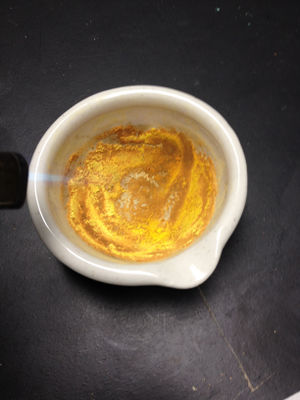Lead(II) oxide
 |
This article is a stub. Please help Sciencemadness Wiki by expanding it, adding pictures, and improving existing text.
|
 Lead(II) oxide being formed by the thermal decomposition of lead(II) carbonate.
| |
| Names | |
|---|---|
| IUPAC name
Lead(II) oxide
| |
| Other names
Lead monoxide
Litharge Massicot Plumbous oxide | |
| Properties | |
| PbO | |
| Molar mass | 223.20 g/mol |
| Appearance | Red or yellow powder |
| Odor | Odorless |
| Density | 9.53 g/cm3 |
| Melting point | 888 °C (1,630 °F; 1,161 K) |
| Boiling point | 1,477 °C (2,691 °F; 1,750 K) |
| 0.0017 g/100 ml | |
| Solubility | Soluble in conc. alkalis, HCl, ammonium chloride Insoluble in dil. alkalis, alcohols |
| Vapor pressure | ~0 mmHg |
| Hazards | |
| Safety data sheet | Sigma-Aldrich |
| Flash point | Non-flammable |
| Lethal dose or concentration (LD, LC): | |
| LD50 (Median dose)
|
2,000 mg/kg (rat, dermal) |
| Related compounds | |
| Related compounds
|
Lead(IV) oxide Lead(II,IV) oxide |
| Except where otherwise noted, data are given for materials in their standard state (at 25 °C [77 °F], 100 kPa). | |
| Infobox references | |
Lead(II) oxide, or lead monoxide, is an inorganic compound and one of several lead oxides. It has the chemical formula PbO.
Contents
Properties
Chemical
Lead(II) oxide is a useful precursor to a variety of other lead compounds, as it is amphoteric. It will react with acids to form lead(II) salts and will dissolve in strong bases to form the plumbite (PbO22-) anion, which can be oxidized to form plumbate.
Lead oxide, when mixed with glycerol, will form a cement, which was used by plumbers to seal pipes. After the two compounds are mixed, the resulting paste expands when it sets and hardens to a cement consistency in a day or three. The setting process is mildly exothermic, similar to other cements.[1]
Physical
Lead(II) oxide has a diverse appearance depending on the manner in which it was produced, ranging from pale orange or apricot-colored to bright yellow, orange, or even red. It is typically encountered as a crusty or fine powder. When lead(II) oxide is heated, it temporarily becomes deeper and more saturated in color, for example changing from a light tan or apricot powder to a rich yellow. It is insoluble in water.
Availability
Lead glass contains the oxide, though it's impractical to extract it from it.
Lead(II) oxide can be bought from chemical suppliers.
Preparation
Lead(II) oxide can be produced either by the oxidation of lower lead oxides or calcination of lead(II,IV) oxide at temperatures over 605 °C. An easier route is thermal decomposition of lead(II) carbonate, which is easily produced by precipitation from any soluble lead(II) salt, but this produces a less colorful product.
Projects
- Lead glass
- Water-proof cement
Handling
Safety
Like most lead compounds, lead(II) oxide is very toxic if consumed, causing long-term lead poisoning and inhaling the dust can cause headaches and dizziness.
Storage
In closed bottles and containers.
Disposal
Lead oxide should be taken to waste disposal centers.